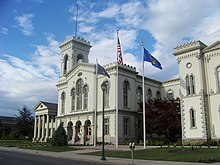Chemung County, New York
| Chemung County, New York | ||
|---|---|---|
| County | ||

Chemung County Courthouse
|
||
|
||
 Location in the U.S. state of New York |
||
 New York's location in the U.S. |
||
| Founded | March 29, 1836 | |
| Seat | Elmira | |
| Largest city | Elmira | |
| Area | ||
| • Total | 411 sq mi (1,064 km2) | |
| • Land | 407 sq mi (1,054 km2) | |
| • Water | 3.4 sq mi (9 km2), 0.8% | |
| Population | ||
| • (2010) | 88,830 | |
| • Density | 218/sq mi (84/km²) | |
| Congressional district | 23rd | |
| Time zone | Eastern: UTC-5/-4 | |
| Website | www |
|
Chemung County is a county in the southern tier of the U.S. state of New York. As of the 2010 census, the population was 88,830. Its county seat is Elmira. Its name is derived from a Delaware Indian village whose name meant "big horn".
Chemung County comprises the Elmira, NY Metropolitan Statistical Area, which is also included in the Elmira-Corning, NY Combined Statistical Area.
Many signs posted along roads in Chemung County refer to the area as "Mark Twain Country," because the noted author lived and wrote for many years in Elmira.
For the history of Chemung County prior to its creation by partition, see Tioga County, New York.
Chemung County was formed from 520 square miles (1,300 km2) of Tioga County in 1836.
In 1854, Chemung County was divided and 110 square miles (280 km2) became Schuyler County, reducing Chemung to 410 square miles (1,100 km2), its current size.
In the late 1870s, the Greenbacker Party became prominent in Chemung and nearby counties in western New York. Here it was primarily allied with labor in a critique of capital, reaching its peak in 1878, the year following the Great Railroad Strike of 1877 and the Scranton General Strike in Pennsylvania. There were also strikes that year in Albany, Syracuse and Buffalo, starting with the railroad workers. In Steuben and Chemung counties, Greenbackers were elected to county councils in 1878 instead of Democrats, and others were elected from there and nearby counties to the state legislature, gaining votes of more than 25 percent in several of the Southern Tier counties. It gradually declined after that, due to internal dissension and the strength of the two major parties.
...
Wikipedia

